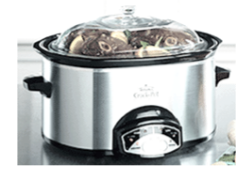7.3: Heating Under Reflux
- Page ID
- 212931
Running organic reactions is a lot like cooking. There are periods when you should heat “the soup” in the pot, covered with a lid, for long periods. If you use a crock pot with a glass lid, you’ll be able to see the following process very clearly (refer to the picture below). Water boils and evaporates by the action of heat, but the lid keeps it from escaping into the atmosphere. Since the lid is usually cooler than the bottom of the pot, and the concentration of vapor is very high at the top, water condenses on the lid wall and falls back into the pot. This state of dynamic equilibrium prevents large losses of water while allowing time for the vegetables and spices to cook for as long as needed (getting hungry yet?).

According to the Webster’s college dictionary, the word reflux comes from the Latin refluxus, meaning “a flowing back.” The reflux process in chemistry is similar to that taking place in the crock pot. After mixing the “ingredients” (starting materials) in a reaction flask, the solvent is allowed to boil for a period of time until the reaction is “done.” The difference is that instead of using a lid to keep the solvent from escaping into the atmosphere, a condenser is used. The condenser cools the solvent vapor and causes it to revert back to liquid. The liquid then falls back into the reaction flask, or “cooking pot.” A typical microscale reflux apparatus is shown in fig. 7.6, p. 601 of your textbook. In the lab we’ll use this same apparatus, but will substitute a sand bath for the aluminum block.
Page 602 gives some guidelines for efficient refluxing. First, the rate of heating should be adjusted in a manner similar to the way you do it when you cook soup. First, you bring the temperature to a high setting just to start the water boiling. Once it’s boiling, you lower the temperature to a minimum, just enough to keep the water boiling (simmering). Likewise, in a reaction which calls for reflux, you bring the temperature to a high value first, to get the solvent boiling. Then you lower the temperature to the minimum value that will sustain the boiling process.
The formation of a “reflux ring” (fig. 7.7) is a good way to monitor the rate of heating. An indication that you are about to form a reflux ring is the formation of liquid droplets above the boiling liquid that look like sweat. As the droplets become more numerous, a well defined borderline forms where the vapor condenses, resulting in a “reflux ring.” The ring will not form unless the solvent is boiling at a steady rate and not too fast. The point at which the rate of evaporation equals the rate of condensation determines is the ideal rate of heating.
Fig. 7.8 B on p. 603 shows a microscale magnetic spin vane, which is used to stir liquids. Stirring is very important to avoid “bumping” any time a liquid is heated. In the event that a magnetic spin vane is not available, use boiling stones, or a boiling (wooden) stick. If you heat a liquid without stirring it can bump, which can result in accidents such as burns. If you use a magnetic spin vane, the reaction flask must be positioned in the center of the hot plate/stirrer. If it’s not, stirring will be difficult, erratic, or even impossible.


